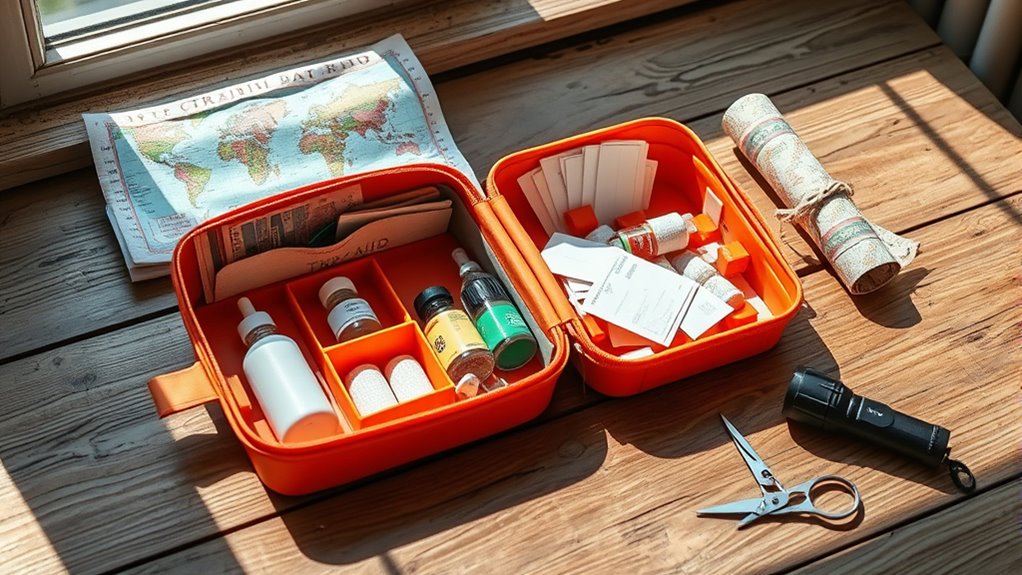To set up your travel first-aid kit, assess your destination’s health risks, climate, and activities. Choose essential supplies like bandages, antiseptic wipes, pain relievers, and personal medications, adjusting for your specific needs. Pick a durable, waterproof container with compartments to keep everything organized. Regularly check and update your supplies, labeling sections clearly. Keep the kit easily accessible and suited to your trip. Keep going to discover tips for organizing and maintaining your kit effectively.
Key Takeaways
- Assess your destination’s healthcare options, climate, terrain, and activities to tailor your first-aid kit accordingly.
- Include essential supplies like bandages, antiseptics, pain relievers, and any necessary personal medications.
- Choose a durable, waterproof container with compartments for organized, easy access during emergencies.
- Label and organize supplies clearly, using tags or color-coding for quick identification.
- Regularly check, update, and restock your kit to ensure all items are current and ready for travel.
Assessing Your Travel Needs and Potential Risks
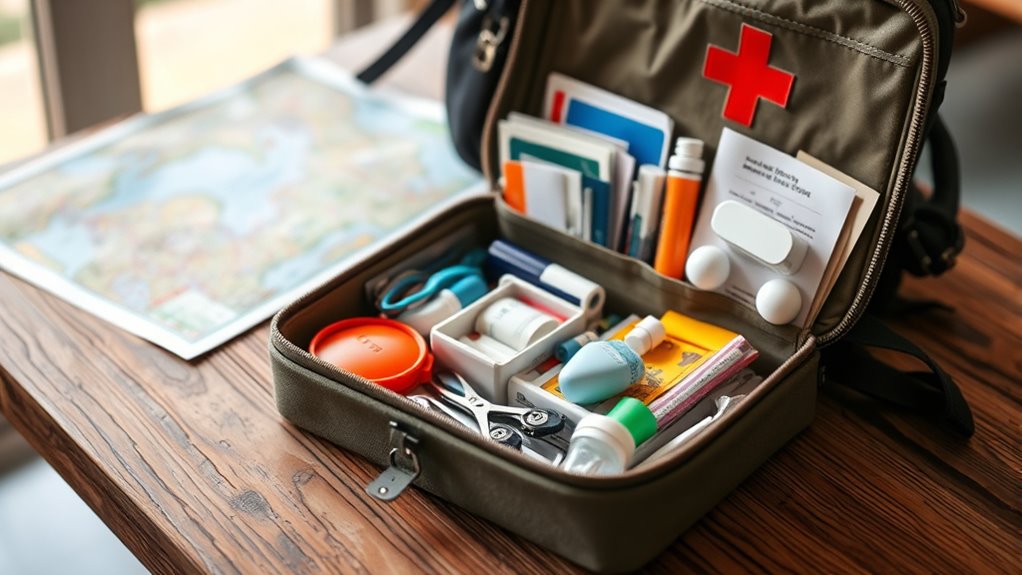
Before packing your first-aid kit, it’s vital to evaluate your travel plans thoroughly. Consider the destination’s healthcare facilities, climate, and terrain. Are you heading to a remote area with limited medical services? Will you be engaging in outdoor activities like hiking or water sports? These factors influence the types of injuries or illnesses you might encounter. Think about your health history, including allergies, chronic conditions, or recent surgeries. If you’re traveling with children or elderly family members, their specific needs matter too. Additionally, understanding the financial impact of medical emergencies can help you prepare better for unexpected situations. Preparing for potential medical emergencies by understanding the costs involved can make a significant difference in your readiness. Conducting a risk assessment specific to your destination can help identify the most likely issues you may face. Assessing these risks helps you determine what supplies are necessary and prepares you to handle potential emergencies effectively. Planning ahead ensures you’re equipped for common issues and can prevent minor problems from turning into major ones. Additionally, practicing mindful decluttering of your kit can help ensure only essential items are included, reducing unnecessary weight and waste.
Selecting the Essential First-Aid Supplies
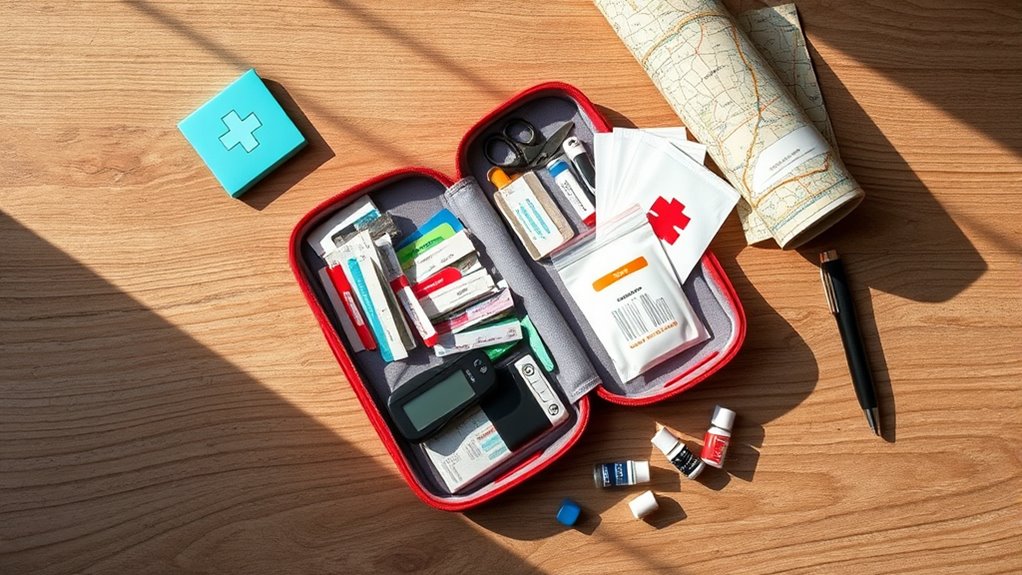
Choosing the right supplies for your first-aid kit is essential to guarantee you’re prepared for common injuries and illnesses during your trip. Focus on basic items like adhesive bandages in various sizes, antiseptic wipes, and antibiotic ointment to treat cuts and scrapes. Include pain relievers such as ibuprofen or acetaminophen, and consider allergy medications if needed. Pack sterile gauze pads, adhesive tape, and scissors for more significant wounds. Don’t forget tweezers to remove splinters, and a digital thermometer for fever checks. If you’re traveling to remote areas, add a whistle for emergencies or a small flashlight. Tailor your supplies based on your activities and destination, ensuring you’re ready for minor injuries or common ailments without overloading your kit. Properly organizing your supplies and understanding toilet buying guides can help you select compact and efficient items suitable for travel. Being aware of symptoms of breast cancer can also be useful, especially when traveling for extended periods, to recognize signs requiring medical attention. Additionally, including Glycolic Acid Benefits for Skin in your skincare routine can help protect your skin from environmental stressors encountered during travel.
Choosing the Right Container for Your Kit
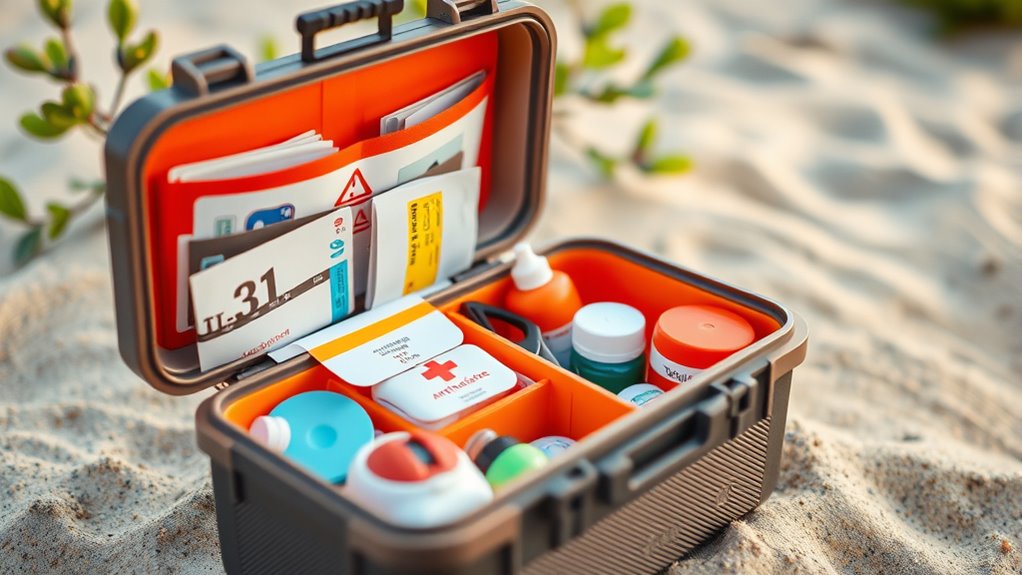
Selecting the right container for your first-aid kit is essential to keep your supplies organized, accessible, and protected. You want a container that’s durable, lightweight, and waterproof, especially since travel can expose your kit to moisture or rough handling. Hard plastic cases with secure latches are ideal because they prevent spills and keep contents safe. Consider compartments or dividers to help organize your supplies so you can find what you need quickly. If you’re backpacking or hiking, opt for a compact, lightweight container that fits easily in your pack. For car travel, a larger, more robust case works well. Whatever you choose, make sure it’s easy to carry, sturdy enough to withstand travel, and able to be sealed tightly. Understanding city dynamics can also help you select a container that suits different environments and ensures your kit’s longevity. Additionally, choosing a container with modifiable features allows for customization based on your specific travel needs and potential emergencies. Incorporating flexible storage options can further enhance organization and adaptability for various situations. Using a container with airtight seals can prevent contamination and moisture damage, extending the shelf life of your supplies.
Organizing and Labeling Your Supplies
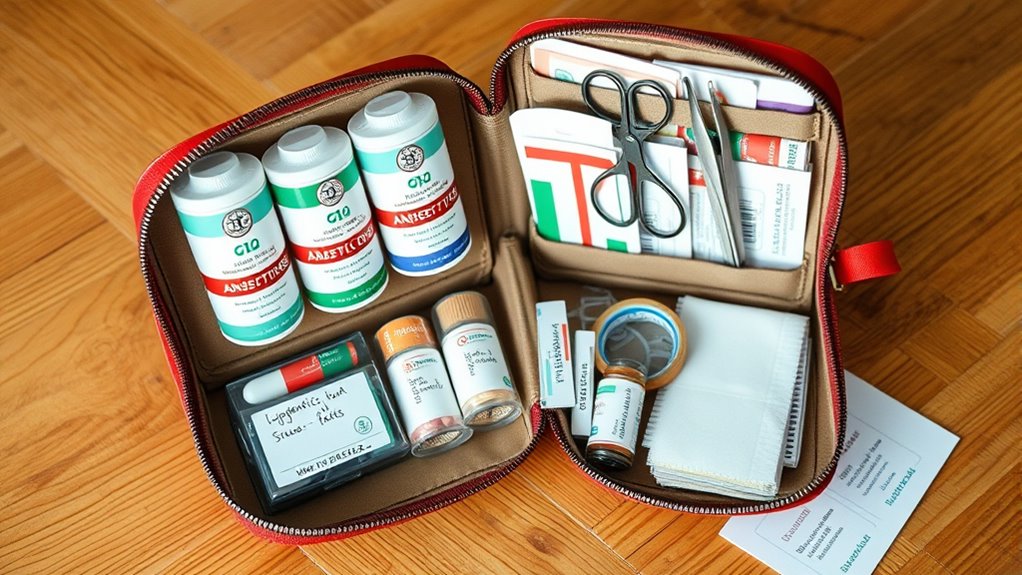
Organizing and labeling your supplies guarantees you can quickly find what you need during an emergency. Start by grouping similar items together, such as bandages, antiseptics, and medications. Use clear, waterproof containers or compartments within your kit to keep things tidy. Label each section or container with bold, easy-to-read tags like “First Aid,” “Medications,” or “Wound Care” so you can locate supplies instantly. Consider using color-coded labels for different categories to boost efficiency. Keep frequently used items at the top or in a designated, accessible compartment. Regularly check your labels and organization system to ensure everything remains clear and functional. Proper organization and labeling save precious moments when every second counts, helping you respond effectively to any injury or health issue while traveling. Additionally, understanding efficient supply management can help you optimize your kit to accommodate potential needs during outdoor adventures, especially when essential oils for first aid can be included for natural remedies. Incorporating first aid supplies organization techniques can further enhance your readiness.
Tips for Maintaining and Updating Your Kit
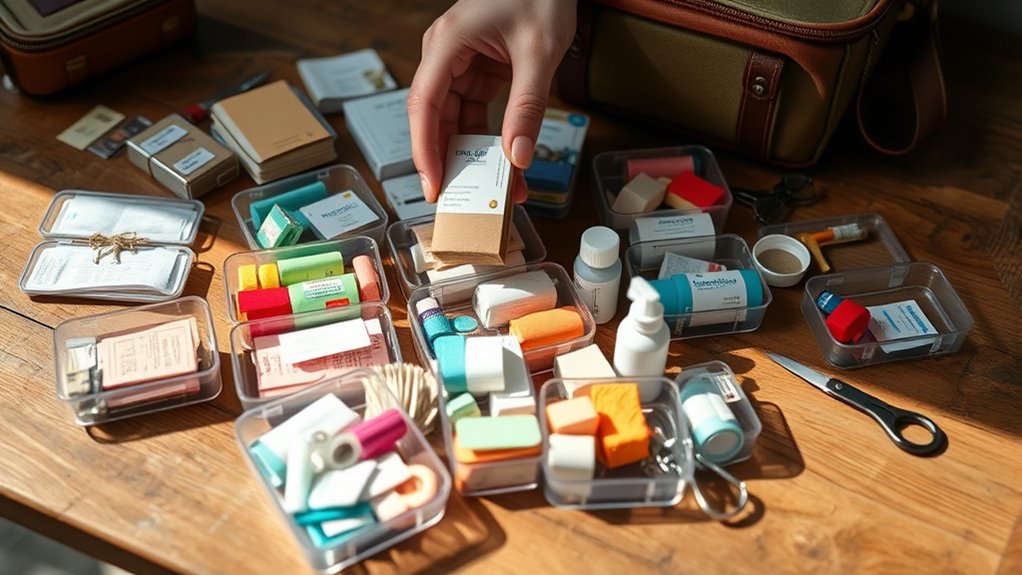
Keeping your first-aid kit up to date is key to making sure it’s ready when you need it most. Regularly check expiration dates on medications, ointments, and antiseptics, replacing items before they expire. Review your supplies to see if anything is used up or damaged, and restock as necessary. Consider your travel destinations—if you’re heading to a different climate or region, update medications or supplies accordingly. Keep a list of what’s inside so you can quickly identify what needs replacing. It’s also helpful to do a quick inventory every few months, even if you’re not traveling soon. Maintaining your kit ensures you’re prepared for minor injuries or health issues, giving you peace of mind during your adventures. Additionally, understanding other age-related conditions can help you better prepare your first-aid kit for specific health needs. Regularly inspecting your supplies for medical-grade materials ensures they remain effective and safe to use in emergencies. Incorporating remote work principles into your routine can also help you stay organized and proactive in managing your health supplies, which aligns with developing powerful persuasive words for effective communication in emergencies.
Frequently Asked Questions
How Often Should I Review and Restock My Travel First-Aid Kit?
You should review and restock your travel first-aid kit at least every three to six months, or after any trip. Regular checks guarantee all supplies are intact and not expired. If you use any items, replace them immediately. Keeping your kit updated helps you stay prepared for emergencies, so make it a habit to inspect it regularly. This way, you’ll always have essential first-aid supplies ready when you need them most.
Can I Include Prescription Medications in My Travel First-Aid Kit?
You can include prescription medications in your travel first-aid kit, but you should follow specific guidelines. Always carry enough medication for your trip, keep it in its original container, and include a copy of your prescription. Make certain to pack any necessary inhalers, EpiPens, or other essential drugs, and store them safely. Consult your doctor before traveling to verify you have all necessary prescriptions and documentation.
What Safety Precautions Should I Follow When Using First-Aid Supplies Abroad?
When using first-aid supplies abroad, you should always read labels carefully and follow instructions precisely to avoid misuse. Keep supplies clean and sterile, and wash your hands before applying anything. Be aware of local health risks and know how to contact emergency services. If you’re unsure about a treatment, seek professional medical help promptly. Staying cautious guarantees your safety and helps prevent complications during your travels.
Are There Specific First-Aid Supplies Recommended for Children or Infants?
When packing a travel first-aid kit for children or infants, you should include child-specific supplies. You’ll want pediatric pain relievers, such as acetaminophen or ibuprofen, and infant-safe antiseptic creams. Don’t forget child-sized bandages, a digital thermometer, and saline drops for nasal congestion. Always carry plenty of wipes and extra diapers if traveling with infants. Tailor your kit to your child’s age and health needs for safe, effective treatment on the go.
How Do I Handle Language Barriers When Seeking Medical Help Overseas?
Ever thought language barriers could turn a simple medical emergency into a comedy of errors? When overseas, carry a translation app or phrasebook for medical terms, and learn basic phrases like “I need help” or “Where’s the nearest doctor?” It’s ironic how a few words can save you from confusion and delay. Be prepared, stay calm, and remember, a little effort bridges the language gap when it matters most.
Conclusion
By evaluating your travel needs and choosing the right supplies, you’ll feel confident tackling minor injuries on the go. Keep your kit organized, labeled, and up-to-date to make sure you’re prepared for any situation. Some say a well-stocked first-aid kit can even boost your confidence and reduce travel stress. So, take the time to set it up properly—you’ll enjoy your adventures more knowing you’re ready for the unexpected. Happy travels!
